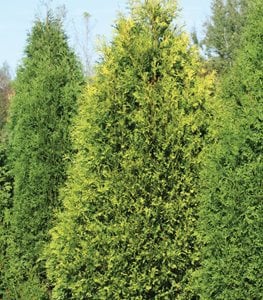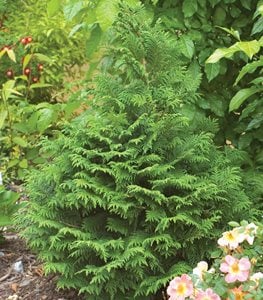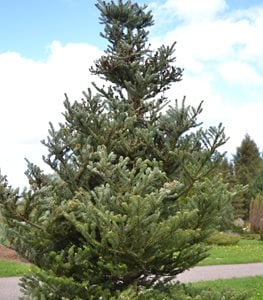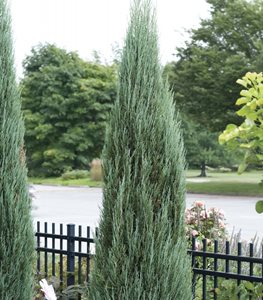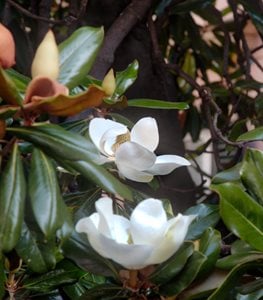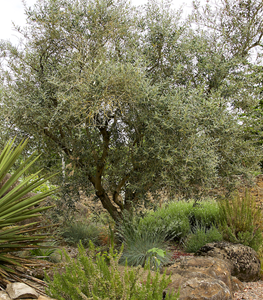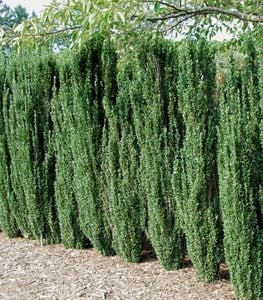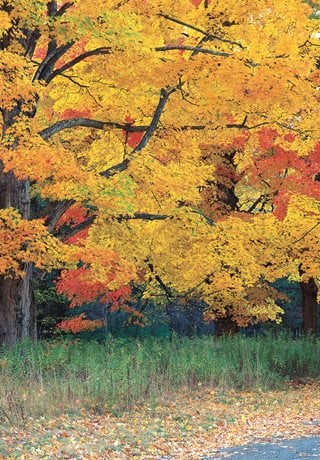The Best Evergreen Trees for Residential Gardens
Modest in size and showy in all seasons, these 12 evergreen trees provide year-round color and structureEvergreen trees, including needle-bearing conifers and broadleaf evergreens, are a welcome sight in any garden because they offer greenery and interest during the dead of winter, when the branches of deciduous trees are bare. In addition to their ornamental value, evergreen trees can serve as windbreaks, privacy screens, and winter shelter for birds and other wildlife. Many conifers also have fragrant foliage and colorful berries, and some broadleaf evergreens will produce showy blossoms and edible fruit.
Perhaps the only downside to some evergreen trees is their size. Certain varieties can grow to towering proportions, quickly overwhelming residential gardens that have limited space. The good news is that many types of evergreen trees have space-saving alternatives that offer all the attributes of their larger cousins but will stay in scale with their surroundings, even when mature. Some dwarf varieties can even be grown in containers if you keep them well pruned. Here are some of our favorite options, chosen for their distinctive foliage, tidy forms, and tolerance to a wide range of growing conditions.
On this page:CONIFERS
POLAR GOLD® Arborvitae
Thuja occidentalis
Zones: 3-7
Exposure: Full to partial sun
Height/Spread: 12 to 15 feet tall, 4 to 6 feet wide
Suggested uses: Screening, mass planting, borders, specimen plant
A narrow, space-saving habit and vibrant golden-yellow foliage that naturally grows into a pyramid shape, so little pruning is required. Adapts to a variety of soil types and weather conditions, but beware of foraging deer, which are attracted to the soft, lacy, aromatic needles.
Learn more about how to grow and care for arborvitaes.
SOFT SERVE® False Cypress
Chamaecyparis pisifera
Zones: 4-8
Exposure: Full to partial sun
Height/Spread: 6 to 10 feet tall, 5 to 6 feet wide
Suggested uses: Shrub borders, hedges, specimen, perennial borders and containers
Soft fern-like foliage and uniform pyramidal structure is similar to dwarf Alberta spruce, but a bit more airy. Leaves are bright green on top, flecked with silver-blue on the undersides.
Learn more about how to grow and care for false cypress trees and shrubs.
HORSTMANN'S SILBERLOCKE Korean Fir
Abies koreana 'Horstmann's Silberlocke'
Zones: 5-7
Exposure: Full to partial sun
Height/Spread: 6 to 10 feet tall (after 10 years), up to 10 feet wide
Suggested uses: Specimen plant, Zen gardens
Soft green needles with silvery white undersides give this unique conifer a flocked appearance. Prominent purple cones in winter contrast beautifully with the silver foliage. Very slow growing up to 20 feet tall, but can be pruned to retain a shrublike appearance.
BLUE ARROW Juniper
Juniperus scopulorum 'Blue Arrow'
Zones: 4-9
Exposure: Full sun
Height/Spread: 16 to 20 feet tall, 2 feet wide
Suggested uses: Narrow privacy screen or hedge, formal garden, flanking an entryway
This super-svelte conifer grows to a width of only 2 feet, taking up little garden space to show off its finely textured, silvery-blue foliage. Covered with blue berries in winter that add ornamental interest and serve as an important food source for foraging birds.
Learn more about how to grow and care for junipers.
SILVER WHISPERS™ Swiss Stone Pine
Pinus cembra 'Klein'
Zones: 3-7
Exposure: Full sun
Height/Spread: 10 to 12 feet tall, 6 to 8 feet wide
Suggested uses: Specimen plant, mass planting, screening, windbreak
Compact, columnar form is densely packed with whiskery plumes of white-striped needles, creating fullness despite the narrow footprint. Adorned with small violet-blue cones in winter. Very cold hardy and drought tolerant.
SLENDER HINOKI Cypress
Chamaecyparis obtusa 'Gracilis'
Zones: 4-8
Exposure: Full sun
Height/Spread: 8 to 12 feet tall, 4 to 5 feet wide
Suggested uses: Screening, hedge, background plant
A narrow, upright cultivar of Hinoki cypress with ferny dark-green foliage that mellows to bronze in winter. The open, alternate branching adds structural interest and is a nice change of pace from the tightly packed, uniform rows of many other conifers. Very slow growing, reaching a height of 6 feet after 10 years.
GOLDEN DUKE® Eastern Hemlock
Tusga canadensis 'MonJers'
Zones: 4-8
Exposure: Full sun or partial shade
Height/Spread: 6 to 10 feet tall, 2 to 3 feet wide
Suggested uses: Privacy screen, specimen plant, windbreak, woodland garden, container
Offering greater sun tolerance than other golden hemlock varieties, this attractive cultivar features gracefully arching branches and luminous golden-yellow foliage that becomes even more intense in color with increased sun exposure. In winter, the foliage deepens to orange, creating a stunning focal point against a backdrop of snow.
BROADLEAF EVERGREEN TREES
LITTLE GEM Southern Magnolia
Magnolia grandiflora 'Little Gem'
Zones: 7-9
Exposure: Full sun
Height/Spread: 15 to 20 feet tall, 8 to 10 feet wide
Suggested uses: Specimen plant, espalier
A dwarf southern magnolia with lush, glossy, two-toned foliage that’s dark green on top and reddish brown on the flip side. Unlike most magnolia trees, it has a narrow, upright form ideal for smaller gardens. From late spring through summer, it bears an abundance of large, fragrant white flowers.
Learn how to grow and care for magnolia trees.
OLIVE
Olea europaea
Zones: 8-11
Exposure: Full sun
Height/Spread: Varies, depending on the cultivar
Suggested uses: Mediterranean-style garden, water-wise garden, container, espalier.
With silvery foliage, gnarled trunks, and fragrant white flowers in spring, olive trees are beautiful garden focal points in all seasons. Although many olive trees can grow to a height of 30 feet, their growth rate is slow and they respond well to pruning to control their size. Or plant a space-saving dwarf variety that grows no taller than 15 feet, such as Little Ollie®. (O. europaea ‘Montra’) or Arbosana (O. europaea ‘Arbosana’).
Learn how to grow and care for olive trees.
SKY PENCIL Japanese holly
Ilex 'Sky Pencil'
Zones: 5-9
Exposure: Full sun to partial shade
Height/Spread: 8 to 10 feet tall, 2 feet wide
Suggested uses: Narrow privacy screen or hedge, formal garden, flanking an entryway, container.
With a spread of only 2 feet, gradually tapering at its base, this aptly named holly maintains its slender form without the need for shearing because of the upward-growing branches. The shiny green foliage holds its color all year and is accented by dark blue berries in fall.
Learn how to grow and care for holly trees.
Also try:
DWARF STRAWBERRY TREE
Arbutus unedo 'Compacta'
Zones: 7-9
Exposure: Full sun to partial shade
Height/Spread: 6 to 8 feet tall, 5 to 6 feet wide
Suggested uses: Specimen plant, informal hedge, Mediterranean-style garden, water-wise garden
A handsome multi-trunk tree with glossy dark-green foliage and cinnamon-colored bark. Covered with small, bell-shaped white flowers from fall through late winter followed by plump, edible, strawberry-like fruit that often appears while the flowers are still blooming. Very drought-tolerant once established.
LITTLE EMPEROR® JAPANESE BLUEBERRY TREE
Elaeocarpus decipiens 'MonProud'
Zones: 8-11
Exposure: Full sun to partial shade
Height/Spread: 8 to 10 feet tall and wide
Suggested uses: Privacy screen, hedge, Zen garden, container, topiary
A beautiful, compact evergreen tree for warmer climates, featuring glossy green leaves, fragrant white flowers, and colorful non-staining blue fruit. New leaves emerge bronze, mature to green, and then change to deep red just before dropping. The dense foliage and tight branching make this a good choice for a hedge or privacy screen.
TIPS FOR CHOOSING AN EVERGREEN TREE
The size of an evergreen tree at maturity is only one of many factors to consider when choosing the best specimen for your garden. Here are other important parameters you should include in your decision-making process.
- Make sure the tree is suitable for your growing zone and climate conditions. While most conifers are very cold hardy, many broadleaf evergreen trees need a warmer Mediterranean or tropical climate in order to survive. It’s also helpful to know the type of soil the tree prefers.
- Although the size of a tree at maturity is important, so is the growth rate. Some evergreen trees grow very slowly, at a rate of only 6 to 8 inches per year. These slow-growing trees require minimal pruning to control their height and form, but they won’t fill gaps in the garden quickly.
- Sometimes the width, or spread, of a tree is more important than its height, especially if you’re dealing with a tight, narrow space. Many newer conifers have very slender, columnar forms that take up little square footage in the garden.
- Because the foliage of an evergreen tree is present year-round, choose a foliage color and texture that will complement your garden in all seasons. Conifers, in particular, offer numerous color options, ranging from silvery blue to bright gold.
- Also consider the density of the foliage, especially if you plan to use evergreen trees to create a windbreak or privacy screen. Conifers tend to be better-suited for these applications because of their tiered branches and feathery needles.
RELATED:
Trees for Privacy
Best Flowering Trees for Residential Gardens
Top Trees for Colorful Fall Foliage
More Trees for Your Garden
